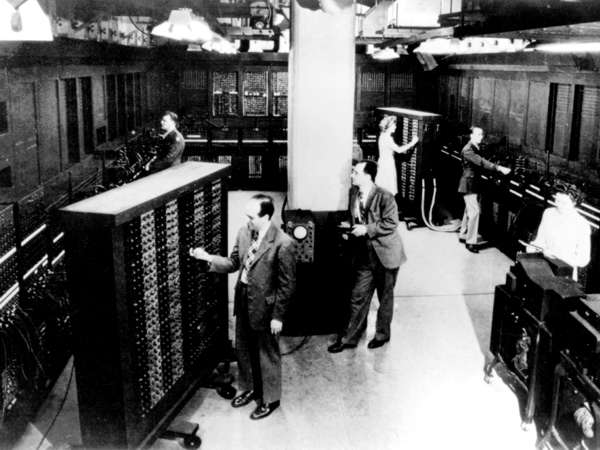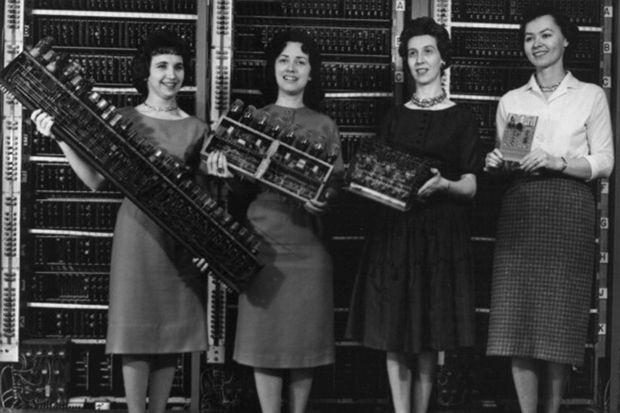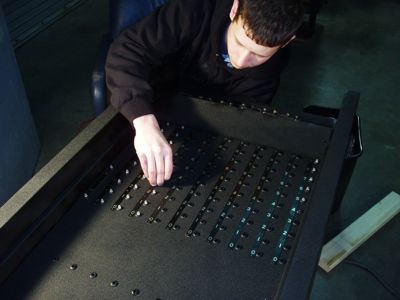| ENIAC Returns To Fort Sill |
| Written by Historian | |||
| Tuesday, 02 December 2014 | |||
|
Almost 60 years after ENIAC was effectively broken up and scattered, a large chunk of it has been put back together. Although not restored to its original functionality, it is back in the location where it operated until 1955, Fort Sill, Oklahoma. Designed and built by John Mauchly and J. Presper Eckert, ENIAC is widely regarded as the first true computer. Work on the Electronic Numerical Integrator and Calculator, to use its full name, started in 1943 with the innovative idea of using valves. The result was a huge machine. It occupied over 1,500 square feet of space and weighed 30 tons. It.used just short of 18000 valves arranged in racks 100 feet long in total. It consumed enough electricity for a small town and disposing of the heat produced by the valves was no small problem. But its claim to fame at the time was its speed of calculation. It could add two numbers in 0.2 milliseconds, or to put it another way performed 5,000 operations per second - 1,000 times faster than its contemporaries.
J. Presper Eckert and John W. Mauchly with ENIAC at the Moore School of Engineering, University of Pennsylvania, 1946.
ENIAC was unveiled at the Moore School of Engineering, University of Pennsylvania, in 1946 and was then used for nearly 10 years by the US Army's Ballistic Research Laboratory located at Fort Sill where it performed a huge amount of computation.
It not only computed artillery firing tables and trajectories but ran the simulations needed for the H bomb. It also caught the public imagination. In a public demonstration it took only twenty seconds to work out the trajectory of a shell that took 30 seconds to reach its target. ENIAC's flashing lights and switch banks also set the look of machines in film and fiction that has hardly changed through to the present day! As has been the case with most of the earliest computers, once it was no longer required nobody thought about preserving it.for its historical significance. Instead it was broken up into 40 panels, each of which weighed an average of 858 pounds. Some were handed out as souvenirs to people involved in the project or in programming it and as a result parts of ENIAC were preserved. Engineer Arthur Burks, for example, donated his panel to the University of Michigan, and a few panels ended up in the Smithsonian.
ENIAC programmers with trophy panels
Other panels might have continued to remain undiscovered in packing crates were it not for Ross Perot, the billionaire collector who ran twice for the US presidency in the 1990s who made his fortune by founding Electronic Data Systems (EDS) which provided data processing services to large corporations and the US government, including computerizing Medicare records. In 2006, Perot declared that he wanted to decorate the Plano, Texas, headquarters of Perot Systems Corporation with relics from computing history. His staff decided to go for something impressive in terms of both size and significance and so set about looking for parts of ENIAC panels. Thanks to Libby Craft, Perot's director of special projects, nine panels were found to be stored at Fort Sill and officials agree to let Perot Systems borrow eight of the panels in exchange for restoring them.
ENIAC panels on display in the Smithsonian
It quickly became obvious that there was no question of ENIAC ever functional in any way but Dan Gleason, a video-conferencing engineer at Perot Systems who had zero experience with fixing vintage computers, and his son Jonathan, decided to at least make it look as it it was working. They sandblasted the panels, painted them with black metallic paint and laboriously soldered 600 new lamp bulbs into place. The bulbs were then connected to a motion sensor to flash in random order when an observer approaches, giving the impression of an operational machine. This seems like a very said end for the historic remains of a very important machine. With so few panels it might have been difficult to stage any sort of reconstruction - even a partial reconstruction - but this is more like a Disney land attraction.
In 2007 the revamped ENIAC went on display at the Perot Systems office building and as this is a secure facility this meant few people had the opportunity to see. However since then the company was purchased by Dell, which recently decided to sell the building and relocate. As a result it was time to return the panels to the Fort Sill Museum where they arrived in late September where the the reduced ENIAC display was quickly restored to working order. And even though the hardware is just flashing lights the photos in the US Army's collection give an impression of what ENIAC was like nearly 70 years ago. Fort Sill may have been the place that ENIAC did most of its work, but given the current focus of it's museum isn't anything to do with computers, it doesn't seem like the right resting place for its remains.
More InformationGroundbreaking WW2 computer put on display in the US One of the first true computers is finally on public display To be informed about new articles on I Programmer, install the I Programmer Toolbar, subscribe to the RSS feed, follow us on, Twitter, Facebook, Google+ or Linkedin, or sign up for our weekly newsletter.
Comments
or email your comment to: comments@i-programmer.info |
|||
| Last Updated ( Tuesday, 02 December 2014 ) |







